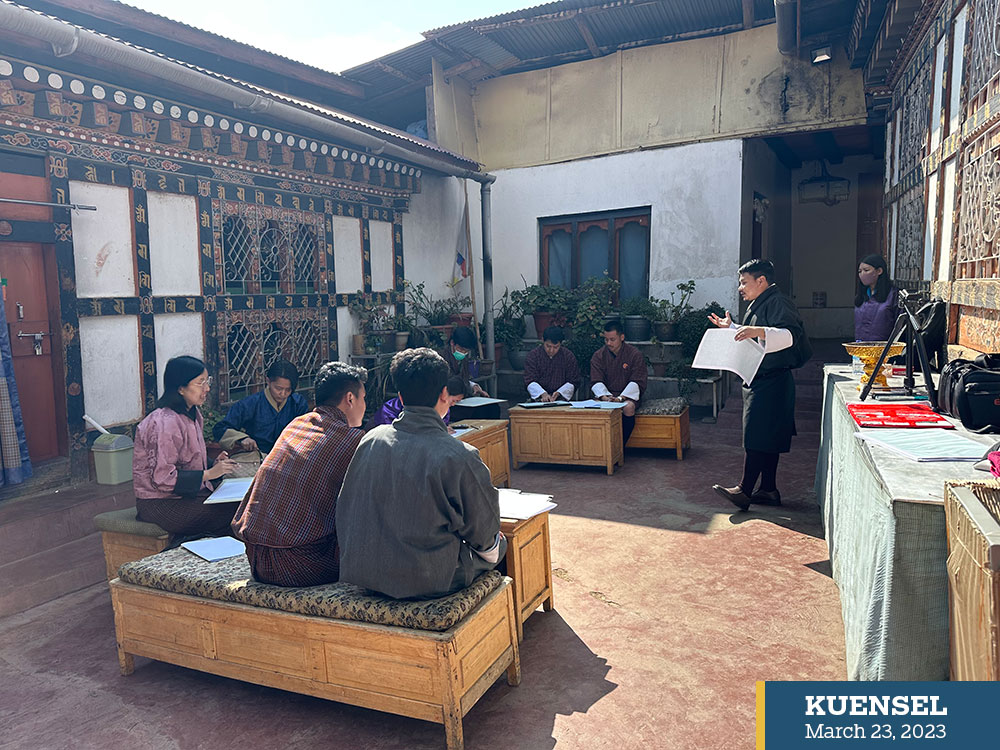Chhimi Dema
Unwarranted reconstruction of conservation sites or monuments is considered a major factor causing the loss of cultural, economic, aesthetic, scientific and educational value of heritage sites if they are not carried out by experts.
The issue is compounded by the lack of conservation experts in the country.
To augment the government’s efforts to preserve Bhutan’s cultural heritage, the Department of Culture and Dzongkha Development is training professionals from the private sector on the conservation of heritage buildings in Thimphu.
The professionals are taught how to document cultural heritage sites and understand the cultural heritage of Bhutan and its values.
This year, Barp Lhakhang at Babesa, Thimphu was chosen as a site for learning. The trainees drew the floor plans and elevation of the Lhakhang, recorded its historical background, and learnt how the lhakhang’s architect changed over time. They observed and took measurements of the lhakhang’s internal and external structures.
Barp Lhakhang is said to have been built in the 15th century. The lhakhang is unique for its architectural arrangement of the main Lhakhang where four statues are supported by a main structure (a pillar) in the middle of the lhakhang. The statues of Mithrub face in four directions, and there is a passage around them for circumambulation.
The professionals after historical research, architectural documentation, and structural assessment of the current lhakhang would prepare a conservation proposal like how the conservation is carried out today.
The department’s executive architect, Yeshi Samdrup, said that the training is organised annually to develop the private sector’s capacities in the conservation of heritage sites.
The first cohort of the training was conducted from February 14 to May 31 last year.
Yeshi Samdrup said that heritage values are lost (the cultural, economic, aesthetic, scientific and educational value of heritage) if the conservation process isn’t done right.
Currently, the department is implementing national heritage conservation projects at Tango, Cheri, Sangchen Choekhor, Chimi Lhakhang, Sarpang dzong and Rigsum Goenpa.
Starting July this year, the government plans to outsource the conservation works to the private sector, Yeshi Samdrup said.
He said that this training is an important step to address the issues of limited private sector professionals in the field of heritage conservation and unwarranted works at heritage sites. “For conservation activities at heritage sites, specialised skills are required. If you lack the proper skill then you could risk losing the heritage sites.”
This training is aimed to give skills to the trainees to carry out restoration works on heritage sites in communities, document local cultural heritages, or serve as consultants in preservation or restoration works.
Kinley Drukpa, an engineer, said that currently, professionals in the private sector are based on modern architecture and that hardly any private firms work in the field of heritage conservation.
“This is due to a lack of skills and knowledge in the private sector,” he said, adding that such training would help private firms interested in venturing into heritage conservation.
Kinley Drukpa said that this training provides opportunities for private firms to take up documentation and construction works at heritage sites while the department guides and monitors the works.
The trainees would receive an assignment after the training based on which they will be certified as heritage managers and experts.
The two-and-a-half-month training will end on April 23 this year.


